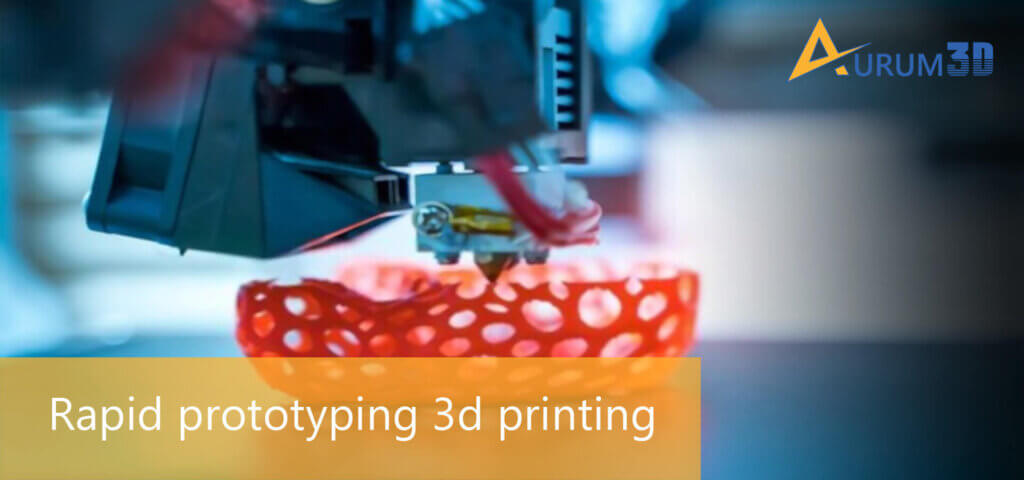Before launching a new product, designers and manufacturers often evaluate a new concept, idea, or process by creating prototypes. As an early model, sample, or release of the product, a prototype makes it easier for decision-makers to produce a simulation of the final product for testing and evaluation purposes. The designers and engineers can create prototypes rapidly using a slew of rapid prototyping technologies.
But most engineers, designers, and manufacturers these days prefer 3D printing or additive manufacturing widely used rapid prototyping technologies. The engineers reduce the time and resources required to create fully functional prototypes using several 3D printing technologies – Fused Deposition Modelling (FDM), Selective Laser Sintering (SLS), Selective Laser Melting (SLM), Digital Light Processing (DLP), and Binder Jetting.
According to Wikipedia,
“Rapid prototyping is a group of techniques used to quickly fabricate a scale model of a physical part or assembly using three-dimensional computer-aided design (CAD) data. Construction of the part or assembly is usually done using 3D printing or additive layer manufacturing technology.”
Many bloggers these days use the terms rapid prototyping and 3D printing interchangeably. But 3D printing is one of the technologies that simplifies and accelerates the creation of prototypes based on CAD design. The engineers can create, upgrade, or modify the prototype simply by making changes to the CAD design. Also, they can obtain the prototype physically using the appropriate 3D printer.
Rapid Prototyping with 3D Printing: Why 3D Printing is more popular than Other Rapid Prototyping Technologies?
Create and Finetune Prototypes Repeatedly
The changing customer preferences and industry trends make it essential for engineers to evaluate and finetune the prototype throughout the manufacturing process. The conventional manufacturing methods do not help designers to create multiple versions of the prototype without putting in extra time and effort.
But 3D printing enables engineers and designers to update the initial version of the prototype throughout the manufacturing process simply by making changes to the CAD file. Also, they can produce the updated version of the prototype physically in a few hours using the appropriate 3D printer.
Reduce Material Consumption and Wastage
Manufacturing companies always explore ways to produce multiple versions of prototypes without increasing material consumption and cost. The subtractive nature of traditional manufacturing methods often increases material consumption and wastage. The methods do not allow designers to provide the desired shape to prototypes only by removing specific parts of the block of materials.
But 3D printing technologies produce prototypes by depositing the material or filaments layer by layer. Hence, the nature of 3D printing helps engineers to reduce both material consumption and wastage. The engineers can further curtail overall material costs by creating prototypes using recycled scrap materials.
Ensuring Accuracy and Precision
The traditional industrial prototyping standards are updated and revised frequently. Hence, the engineers find it challenging to maintain quality and consistency while creating and finetuning prototypes during the manufacturing process. 3D printing technologies help designers and engineers to overcome this major shortcoming of traditional industrial prototyping standards by facilitating rigorous testing and quick remodeling.
The designers can use a 3D printer to keep product design accurate and precise by performing rigorous and continuous testing. At the same time, they can ensure accuracy and precision by making changes to the CAD design according to the latest test results. Also, they can eliminate errors in the prototypes by conducting virtual product trials from time to time.
Foster Creativity and Innovation
The conventional manufacturing methods make it difficult for engineers and designers to experiment with innovative concepts and out-of-box ideas. The engineers have to focus on reducing prototyping time and cost while evaluating and implementing ideas.
But 3D printing technologies enable designers to focus only on thinking freely, evaluating ideas, and adding design elements. They are no longer required to explore ways to curtail costs or assembling multiple parts. Many engineers these days use 3D printers to create innovative and outstanding products by unleashing their creativity and imagination.
Avail of Manufacturing as a Service (MaaS)
Unlike large manufacturing companies, small manufacturers and startups often lack the skill and resources required to promote rapid prototyping by investing in high-end 3D printers and 3D modeling software. Professional 3D printing service providers make it easier for small manufacturing companies to produce prototypes by availing of Manufacturing as a Service (MaaS) just like Software as a Service (SaaS).
They help designers and decision-makers to get prototypes physically in a few hours without investing in 3D printing technologies. Many 3D printing service providers help manufacturers to create CAD files and get 3D-printed prototypes simply by sharing the ideas, concepts, and requirements with their in-house designers and engineers.
Facilitate Unambiguous and Seamless Communication
The quality and profitability of the final product are impacted when the designers do not convey the design concepts to various stakeholders – production engineers, marketers, clients, and collaborators. The designers can convey the design concepts clearly and effectively to stakeholders by sharing 3D-printed prototypes.
The 3D-printed prototypes ensure that all stakeholders are on the same page while evaluating or discussing the complex designs, ideas, and concepts. The designers can use a 3D printer to produce multiple copies of the prototypes in a short amount of time. They can even share the CAD files with various stakeholders to discuss and evaluate ideas before producing the prototype physically.
Utilize Facilities and Resources More Efficiently
Often businesses fail to utilize manufacturing capacity fully due to inefficient utilization of resources and facilities. The conventional manufacturing methods do not allow manufacturers to choose and use materials flexibly. But 3D printing helps businesses to keep the manufacturing process flexible and efficient.
A manufacturer can use the same 3D printer to create a variety of prototypes. They can use a single 3D printer to produce fully functional prototypes one after another without any time gap. Many manufacturers these days leverage artificial intelligence (AI) and machine learning (ML) to automate the 3D printing process seamlessly.
The use cases of 3D printing differ across industries. But enterprises from various industries these days leverage 3D printing technologies to facilitate rapid prototyping. However, the decision-makers must focus on a slew of factors to create prototypes rapidly and accurately. They have to choose the appropriate 3D printer by considering important factors like 3D printing technology, print materials, build volume, size, and cost.

